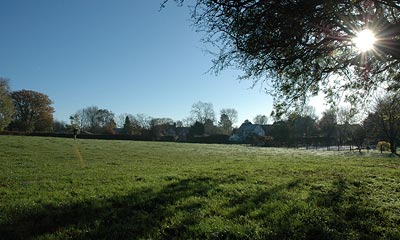When Nimbies are right to mind the gap
Villages could merge in a hideous suburban sprawl under Labour’s plans, protesters tell Liz Hodgkinson.
Only a few days into her new job, Ruth Kelly was declaring war on Nimbies. But, rather embarrassingly for the Communities and Local Government Secretary, she was revealed to have helped block developments in her own constituency of Bolton West - thus displaying herself as the ultimate Nimby - Not In My Backyard - campaigner.
Kelly particularly vowed to tackle residents who oppose plans for "affordable" housing but residents of Hertfordshire, one of the most threatened counties under Deputy Prime Minister John Prescott's plans, believe that very little social housing will go up anyway, and that, instead, loads of executive-style homes will be built.
In any case, they maintain, they are not against social housing as such, but opposed to building on greenfield, instead of brownfield, sites.
"We are all for affordable housing in the right places, where account has been taken of environmental issues and where it’s not just a matter of grabbing greenfield," says campaigner Kevin Fitzgerald, whose own town of Knebworth is severely under threat.
The Hertfordshire plans, which are about to be presented to Kelly, include up to 20,000 new houses on greenfield sites of which 25 per cent are supposed to be affordable.

"There is definitely going to be a great deal of new building in Herts and the reality is that hardly any of it will be social housing," adds Kevin, who is director of his local branch of the Campaign to Protect Rural England. "Many areas around Stevenage have been earmarked for vast new estates, and Stevenage itself is designated a 'sub-regional centre' - a new, ominous-sounding term.
"Our main fear is that Herts, which currently consists of little market towns and villages separated from each other by countryside, will become a vast urban sprawl rather like Middlesex where you only know whether you are in Ruislip or Pinner if you see the appropriate sign. We have so far managed to retain our separate towns, such as St Albans, Baldock, Letchworth and Welwyn Garden City, and we want to prevent so-called coalescent settlements, where separate villages and towns no longer exist."
Once upon a time, the Cambridgeshire villages of Melbourn and Meldreth, two miles apart from each other, were quite separate. Now they have been joined together by many new estates, all built on greenfield land.
All these estates, says Cambridgeshire resident, retired furniture restorer Sean Traverse-Healy, are full of executive-type homes, lived in by commuters, and there is virtually no social housing. And the coalescence of these two villages is not yet over. Sean says: "There are constantly new planning applications being put forward and although they are not all agreed, many do go through. I have watched many separate villages being joined up, and it's a gradual process that happens in small steps, so that the encroachment is not really noticed until it's too late."
At the moment, Hertfordshire, unlike Middlesex and much of Cambridgeshire, still has a tiny chance of preserving its character, as most of the projected housing has yet to be built. "The countryside here is particularly precious for being so near London," says Kevin. "Herts is currently very desirable and we want to keep it that way. The term Nimby is used pejoratively, but people take a pride in their surroundings and there is no doubt that areas lose value and become less attractive when they are all joined up by acres of new housing.
"We are not against social, or affordable housing and would like more in the area, but we don't want cheap and nasty boxes huddled together on greenfield sites next to the executive-type homes."
At the moment, an acre of green land without planning permission costs £3,500 in Herts. Much of it has already been snapped up by construction companies who are sitting on it, waiting for permission to build. This is mainly agricultural land that struggling farmers have been only too happy to sell.
Developers are strangely reluctant to build on the existing brownfield sites. "Developers argue that they want to build on brownfield sites but there just aren't any that are suitable," says Sean. "And they always negotiate down the amount of affordable housing that they agree to build."
Kevin is also concerned at an apparent reluctance by developers to build on brownfield sites. "We believe it is possible to do less damage by looking at brownfield sites, but the pressure is on from developers for green fields, as they can then build expensive houses, and the profit margin is so much higher."
A similar problem is likely to confront the Thames Gateway area, which extends from Tower Bridge to Sheerness on the south side and Shoeburyness and the Isle of Sheppey on the north side.
Up to 200,000 new homes are planned here but again the fear is that the area may become one vast urban sprawl. Nigel Kersey, Thames project leader for the CPRE, says: "Thames Gateway is the best place in the country to build new housing as it has the highest percentage of derelict urban land and desperately needs regenerating. The idea was first mooted by Michael Heseltine 10 years ago and was eagerly identified by Prescott three years ago as a growth area.
"As an organisation, our main concern is that not enough brownfield sites are being used and not enough affordable housing is going up as developers make more money at the expensive end. In the East Midlands, for instance, there was a target of 25 per cent affordable housing but only seven per cent was actually achieved.
Despite these concerns, Kelly is now planning to introduce regulations that will make it harder for residents to oppose new social and other housing, but she will have to contend with the CPRE, now fiercely campaigning to preserve the precious little bits of countryside we have left.
telegraph.co.uk, 17.05.2006
